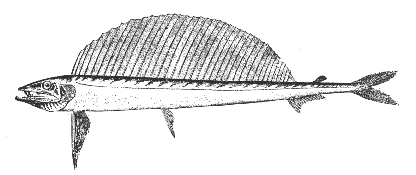Lancetfish Alepisaurus ferox Lowe 1833
HANDSAWFISH
[Jordan and Evermann, 1896-1900, p. 595.]

Figure 75.—Lancetfish (Alepisaurus ferox). New York market specimen. From Jordan and Evermann. Drawing by H. L. Todd.
Description—
The combination of a long and very high dorsal fin, soft-rayed from end to end, with the presence of an adipose fin behind it, distinguishes the lancetfish from all other Gulf of Maine fishes. The body is slender, somewhat flattened sidewise, deepest at the gill covers, and tapers back to a slender caudal peduncle. The snout is long and pointed, the mouth wide, gaping back of the eye, and each jaw has two or three large fangs, besides smaller teeth. The dorsal fin (41 to 44 rays) originates on the nape and occupies the greater length of the back, is rounded in outline, about twice as high as the fish is deep, and can be depressed in a groove along the back. The adipose fin recalls that of the smelt in form and location. The caudal is very deeply forked; its upper lobe is prolonged as a long filament, and although most of the specimens so far seen have lost this we have an excellent photograph showing it. The anal fin originates under the last dorsal ray, and is deeply concave in outline. The ventrals, are about halfway between the anal and the tip of the snout, while the pectorals are considerably longer than the body is deep and are situated very low down on the sides. There are no scales and the fins are exceedingly fragile.
Color—
Sides described as metallic silvery. We have not seen a newly taken specimen.
Size—
The collection of the Boston Society of Natural History contains the cast of a specimen about 6 feet long that was taken off Nova Scotia in August 1910, and this is probably about the maximum size.
Habits—
This is an oceanic species, of the mid-depths, appearing only as a stray shoaler than 200 fathoms. Nothing is known of its habits. A Block Island specimen had eaten a small spiny dogfish.
General range—
Widely distributed in the deep waters of the Atlantic, also reported from the northeastern Pacific.[87]
Occurrence in the Gulf of Maine—
A specimen brought in by a fisherman from Georges Bank[88] about 1878 or 1879 is its only claim to mention here. Goode and Bean and Vladykov and McKenzie[89] have reported other captures of lancetfishes from La Have Bank, from southeast of Emerald Bank and Banquereau. Another specimen 51/2 feet long was caught alive in the surf on Block Island, R. I., March 12, 1928, and reported by Mrs. Elizabeth Dickins who sent us a photograph of it.